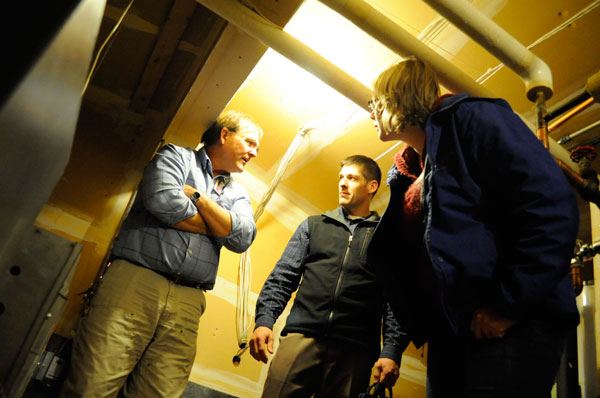by MARK ST.J. COUHIG
Sequim Gazette
Two officials with the Olympic Region Clean Air Agency (ORCAA) were in Sequim on Friday to begin the process of implementing the agency’s new Clallam County Saturation Study.
The demand for the new study was largely driven by concerns regarding a new biomass-burning cogeneration plant now under construction at Nippon Paper Industries in Port Angeles.
Mark Moore, network administrator monitoring specialist for the agency, said he and ORCAA senior air monitoring specialist Odelle Hadley “were here to look for a few sites” where temporary monitors will be placed for the year-long study. Through the saturation study the agency hopes to determine the current state of Clallam County’s air quality for particulates, including PM2.5 and PM10 (See box). The collected data also will help ORCAA determine the best placement for the one or more permanent air monitors it eventually will install in Clallam County. The permanent monitors are much more expensive, which means that properly siting them is very important, Hadley said.
The saturation study will utilize four temporary monitors, with one in Sequim and three in Port Angeles. While in Sequim, Moore and Hadley stopped by Helen Haller Elementary and Sequim Middle School where they met with facilities managers. Moore said the two schools are among their preferred locations because they are centrally located within an urban area, where air pollutants are likely to be greater. He added that he hoped the schools, which are public facilities, won’t charge a rental fee for the required space.
“Clearly, an in-kind contribution by any of the site custodians would be a great help,” he said. “Money’s tight all across the board.”
Cutting costs
The agency’s board approved the budget for the saturation study during its Wednesday, Nov. 14, meeting.
ORCAA Executive Director Fran McNair said the new budget provides a little more than $23,000 in capital funding for fiscal years 2013 and 2014. That’s enough funding to purchase the needed air monitors.
The operational budget for the study is just shy of $17,000, but McNair said they hope to reduce those costs by “getting local people to help us.” Avoiding rental fees on the space would play a big role.
The data produced by the monitors will be collected by unpaid interns. McNair said her agency has contacted Peninsula College to see if it would like to participate.
To help further boost the budget for the study, ORCAA has agreed to devote to the project more than $52,000 of in-kind services by its own staffers.
ORCAA hopes to have all four of the temporary monitors operating by the end of December or in early January 2013.
Up in the air
Through the saturation study ORCAA hopes to determine the changes that have taken place in local air quality since a previous study was conducted 15 years ago. ORCCA notes that in that time numerous significant changes have taken place in Clallam County, including the closing of the Rayonier and K-Ply mills.
They also intend to measure “additional adjustments in emissions around Port Angeles (that) will occur when Nippon replaces its old biomass boiler with a new boiler, which is expected to begin operation in late summer of 2013.
ORCAA officials say they have a good idea what to expect when the new boiler replaces the old one. “Compared to average annual emissions between 2003 and 2009, Nippon’s new emissions are expected to produce significant changes, with PM2.5 reduced by 64 percent, SO2 (sulfur dioxide) by 6 percent and NOx (nitrogen oxide) rising by 38 percent.”
They say these emission changes will result from the improved control technologies in the new boiler.
Study criticized
The study was the subject of an ORCAA meeting in Sequim held Monday, Oct. 15.
Most of those in the crowd of 100 or more were unimpressed with the plan, saying they were concerned the monitors won’t register the presence of ultrafine particles. Critics of the biomass boilers have regularly stated that these tiny particles are the most dangerous.
Bob Lynette, a spokesman for the Sierra Club, told the board he was “glad to see some movement, but I don’t think it’s sufficient.”
Lynette noted “the proposed temporary monitors will only measure particles down to 0.3 microns. But the ultrafine particulates that are very damaging to human health are defined as 0.1 microns and smaller … These smaller ultrafines and the even-smaller nanoparticles, which are greater in number, will not be counted by the proposed temporary monitors.”
In response to demands that the new monitors measure the ultrafines, Hadley told the audience, “no one in the country monitors for ultrafines, and if we did, there are no standards in place.”



